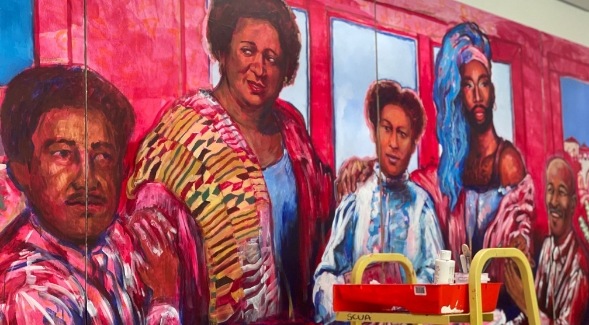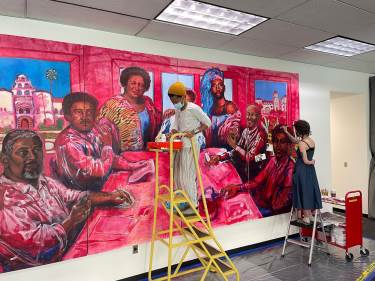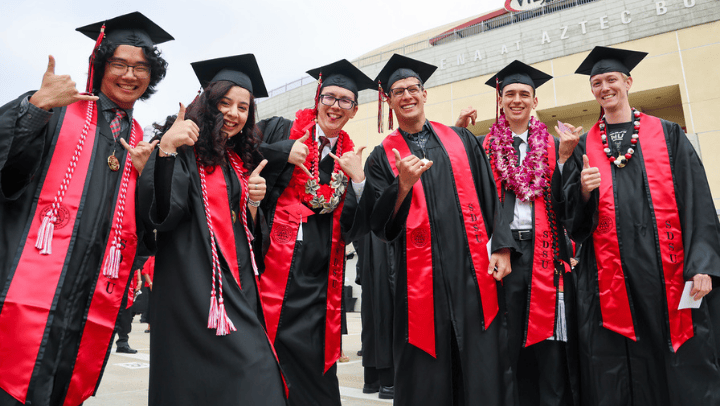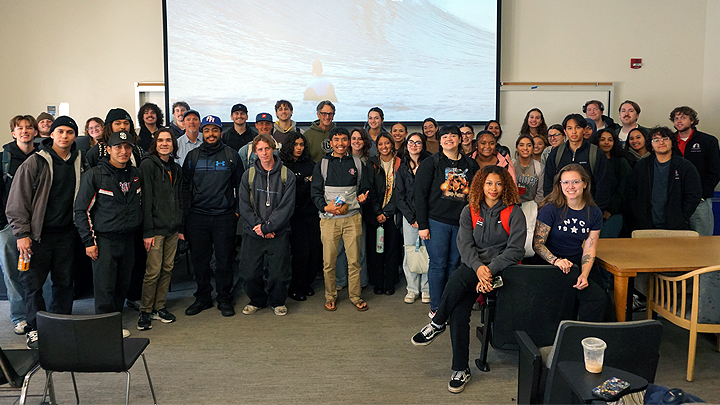SDSU 125 Years: Mural Honors Stories of Black Campus Leaders
Shirley Weber, Charles Bell, E. Walter Miles among the seven stories featured in 16-foot-by-8-foot mural.

Woven into the rich tapestry of San Diego State history are the stories and contributions of countless Black campus leaders.
There’s Henrietta Goodwin, the first Black student to graduate from the university’s predecessor, the San Diego Normal School, in 1913.
There’s E. Walter Miles, the late longtime political science professor known affectionately as the “Godfather of Black Faculty” at SDSU.
And Harold “Hal” K. Brown, who became the university’s first black administrator in the 1970s and established the Afro-American Studies program in 1972 – one of the first of its type.
One of Brown’s first faculty recruits was Shirley Weber, a professor and later department chair who became a giant on campus before her ascent to the top echelon of California government as secretary of state.
The stories of these and several other Black alumni will shine brighter in university history with the unveiling this month of a mural on the first floor of the University Library Addition as part of SDSU’s 125th anniversary celebration.
SDSU alumni and muralists Sabrina Davidson and Avia Ramm were selected to create the mural, which also features the late Charles Bell, a mathematician who became the university’s second Black professor in 1958; drag icon and activist Amber St. James; and former longtime professor, dean of the College of Education and interim provost Joseph Johnson.

“I am so grateful that these important leaders in SDSU's history will be honored with this mural,” said Annie Buckley, a professor in the School of Art and Design and director of the Institute for the Arts, Humanities, and Social Justice, who has partnered with the Division of Student Affairs and Campus Diversity to plan and coordinate the mural.
”The contributions of our Black alumni are integral to SDSU, so the 125th celebration would not complete without including them.”
The 16-foot-by-8-foot mural, painted in an array of red, aquamarine and buff white hues of acrylic paint, depicts its seven figures literally with a place at the table, windows onto the SDSU campus behind them. A bouquet of flowers at the center of the table alludes to the saying “give them their flowers,” or, to pay homage to them.
The genesis of the mural dates back to Juneteenth 2020 in the wake of the protests following the deaths of George Floyd, Breonna Taylor and Ahmaud Arbery.
SDSU released a 10-point plan to enhance support for Black students, faculty, and staff on Juneteenth, including a partnership with Arts Alive SDSU, calling on the partnership to design and facilitate “three placemaking projects across the campus that addressed the history and contributions of Black people and communities.”
J. Luke Wood, vice president of Student Affairs and Campus Diversity, directly requested the library mural, which cost $15,000. Wood, in concert with the African American Alumni Chapter of SDSU and retired SDSU librarian Robert Fikes, selected the alumni that would appear in the art. Fikes is the author of a book detailing the contributions of SDSU Black alumni, "The Black in Crimson and Black.”
“As an administration, we committed to fostering physical environments that demonstrate that our university is a place of belonging and home for our Black community.” Wood said. “We want students to see themselves in the history of this institution and the important strides SDSU has made to transform our local community and the nation.”
Davidson was the first student to apply for the institute’s “Make Your Mark” program, a program started by Buckley that encouraged student artists to create art on the walls of the institute.
A 2021 graduate from Dallas, Texas, Davidson said she was honored to be a part of the “inspiring” project. As a Black woman who attended the university, she said, representation matters.
“I appreciate not only the representation, but it also shows that we have done some amazing things,” Davidson said. “I didn’t realize some of our accomplishments on campus until this project came along. When it’s completed, I hope that other students will see it and know they are not alone, and that so much that has happened in our history here. We have a legacy.”
Ramm, who graduated in 2020, created a powerful mural in the School of Art and Design, which she proposed to honor the global protests against systemic racism in the summer of 2020. Completed last year, the mural is displayed on an interior wall of the Art South building.
“Together, their experience, dedication, and enthusiasm was a great fit,” Buckley said. “Their styles are representational but a bit more expressionistic than initially planned. I like how they have added symbolism and color to support the narratives of each subject included.”
Weber, one of the living legends being memorialized in the mural said she considered it an honor.
“Coming to San Diego State University at an early age was a unique opportunity,” she said. “I was part of a movement on campus that would ultimately affect the lives of thousands of students. At 23, I was given the responsibility to help develop the curriculum for a new department, while also navigating the sometimes friendly but often hostile, academic politics of the time.
“To be a part of this mural with colleagues who worked with me and did so much to contribute to the diversity of SDSU’s academic life is an extraordinary honor.”



